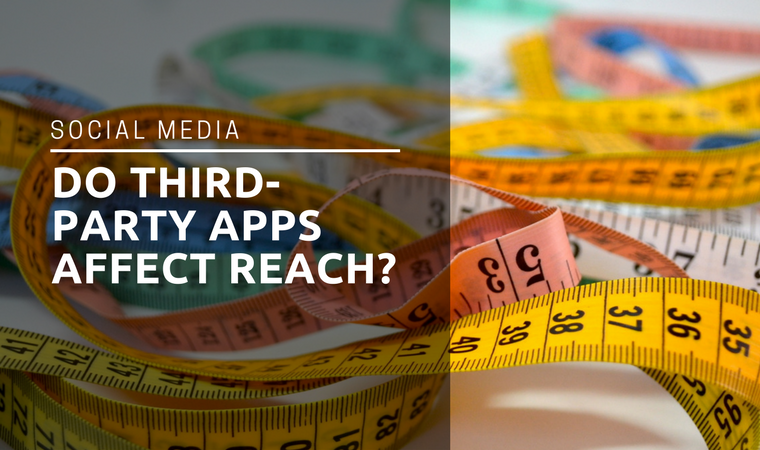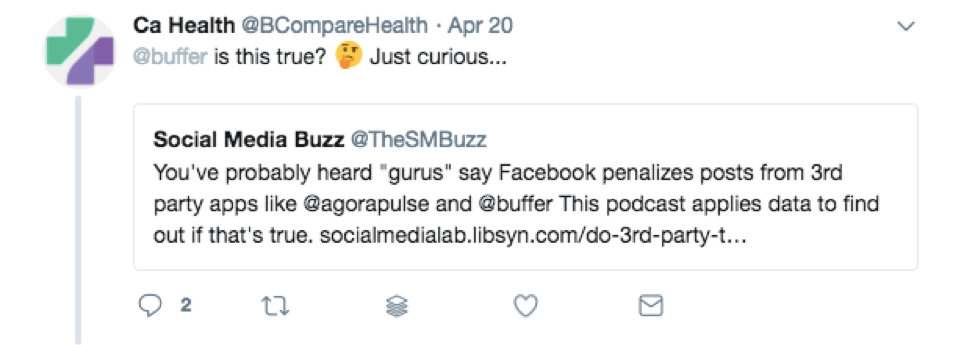Digital content strategists are in a constant state of questioning and optimizing (at least, good ones are), and one such question has stuck around for many years:
How does using third party applications for social media posting impact reach?
It’s a great question for anyone running a brand’s social media campaign to be asking, and the answer has changed time and again as social media networks update their algorithms.
The internet has been wondering the same thing for years. Information on this topic has evolved along the way as social media applications become more sophisticated, algorithms change and the role of brands in the online conversation has shifted. The answer is often hazy and unclear.
Lucky for us, some experts have done tests on this topic to put the question to rest.
Third Party App Research
The top, most current studies on this topic were run by Buffer and AgoraPulse, with similar findings:
1. Over a period of weeks, across several posts and varied accounts, there were very slight differences in reach between posts published directly through social networks and those published through a third party app
2. The winner of these tests (third party or direct posting) varied by brand and channel, without any clear reasons for it
3. The differences in reach for all cases were ultimately deemed statistically insignificant, meaning that variation likely had more to do with random differences between specific posts than the publishing source
As you may have already observed, both studies were run by companies that sell third party posting services.
What’s more, both of these services offer a feature that is supposed to optimize the timing of posts to maximize reach—so if there is really no discrimination from social media networks, I would expect that feature to make posting through a third party more advantageous. There is no indication of whether this feature was used in the tests.
Bottom line? According to these tests, most brands will not see a difference worth noting, most of the time, across most platforms.
Our Own Investigation
Particularly when it comes to “most of the time,” we don’t like to leave it to outside “experts” to make our strategic decisions for us. This is even more true when the parties executing the studies have a vested interest in the results.
We felt this was of particular interest in the wake of Facebook’s shift at the start of 2018 to prioritize “meaningful social interactions.” This has impacted page activity in a number of ways, and we wondered if this was one of them. The two studies mentioned above were executed prior to this latest update.
So, the Stanton team did some experimentation of our own. And our findings were a little different.
For our own outreach and for that of a client with a significant following, we found that engaging directly through both Facebook and Twitter resulted in consistently higher reach.
We came to this conclusion after a focused shift in approach, looking at one brand at a time, and comparing trends in average reach over a few weeks before and after changing to manual posting on the network. As with the studies above, there is no way to perform a true A/B test, but for each of these accounts, the winner was clear.
So What To Do With This Mess?
Ultimately, it’s not about what works for Buffer, or Agorapulse, or Stanton, or any other brand. It’s about what works for your brand, with your audience.
In a race where the winner never seems quite clear and the rules are changing frequently, the only way to really know is to test.
Hopefully, you are already tracking and monitoring your social media performance on a regular basis, which will give you a threshold of reach to compare to. Next, define a period of time and test just this one aspect of your posting process, keeping everything else (post times, content, style) as consistent as possible. If you already use a scheduling application, try posting direct to each network for this period. If you’re not using one, it’s a great time to set up a free trial with a service.
When you get to the end of your test timeline, look at your analytics. Is there a clear winner?
Balancing Consistency and Reach
Even if live posting proves to deliver better reach for you, there are still times when a scheduling tool can enhance your overall social media use. For example, if you know a major awareness initiative related to your brand is coming up in a few months and you come across great content for it, you don’t have to worry about remembering that article a few months later—you can schedule it now and know it will be there.
And if third party posting performs better for you, there is still good reason to get on the actual social media networks on a regular—dare I say daily—basis. There is simply no substitute for being present to understand and engage with your following, no matter what you publish your posts through.


